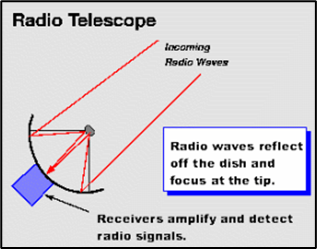In News:
- SARAS 3, a radio telescope designed and built at the Raman Research Institute (RRI), Bengaluru, has revealed information about the origins of the Universe's first stars and galaxies.
What’s in today’s article:
- About radio telescope
- About SARAS 3
- News Summary
About Radio telescope:

- Optical telescopes collect visible light, bring it to a focus, amplify it and make it available for analysis by various instruments.
- Similarly, radio telescopes collect weak radio light waves (usually referred to by its frequency), bring it to a focus, amplify it and make it available for analysis.
- Radio telescopes are used to study naturally occurring radio light from stars, galaxies, black holes and other astronomical objects.
- They can also be used to transmit and reflect radio light off of planetary bodies in our solar system.
- Naturally occurring radio waves are extremely weak by the time they reach earth from space.
- Therefore, detecting the signal even using the most powerful existing radio telescopes, has remained a challenge for astronomers.
- These specially-designed telescopes observe the longest wavelengths of light, ranging from 1 millimeter to over 10 meters long (visible light waves only a few hundred nanometers long).
About Shaped Antenna measurement of the background Radio Spectrum 3 (SARAS) telescope:
- Experiment and science:
- SARAS is a niche high-risk high-gain experimental effort to design, build and deploy in India a precision radio telescope.
- The CMB Distortion Laboratory at RRI has pioneered the development of state-of-the-art radio telescopes which are designed to detect signals of high wavelength and low frequency.
- Latest unique deployment over water:
- In 2020, the radio telescope was deployed in lakes in Northern Karnataka, on Dandiganahalli Lake and Sharavati backwaters by the RRI.
- This intelligent design substantially enhanced telescope performance and had never been conceived of in the world.
- This helped provide a homogenous medium below the antenna improving sensitivity and reducing confusing radio waves emitted by the very ground beneath radio telescopes.
- Significance of SARAS 3 telescope: It is indeed the first experiment to reach the required sensitivity and cross-verify the claim of the signal detection.
News Summary:
- Researchers from RRI, the Commonwealth Scientific and Industrial Research Organisation (CSIRO) in Australia, etc., used data from SARAS-3 to throw light on the energy output, luminosity and masses of the first generation of galaxies.
- Scientists study properties of very early galaxies by observing radiation from hydrogen atoms in and around galaxies, emitted at a frequency of approximately 1420 MHz
- The radiation is stretched by the expansion of the universe, as it travels across space and time and arrives at Earth in lower frequency radio bands 50-200 MHz, also used by FM and TV transmissions.
- According to the RRI, in a first-of-its-kind work, using data from an Indian telescope, scientists have determined properties of radio luminous galaxies formed just 200 million years after the Big Bang, a period known as the Cosmic Dawn.
- SARAS 3 has improved the understanding of astrophysics of Cosmic Dawn. It has shown that less than 3% of the gaseous matter within early galaxies was converted into stars, and that the earliest galaxies that were bright in radio emission were also strong in X-rays.
- Earlier the SARAS-3 team used the same data to reject claims of the detection of a signal from Cosmic Dawn made by the EDGES radio telescope developed by researchers from Arizona State University (ASU) and MIT, USA.
- SARAS-3 has been able to put an upper limit to excess radiation at radio wavelengths, lowering existing limits set by the ARCADE and Long Wavelength Array (LWA) experiments in the US.










